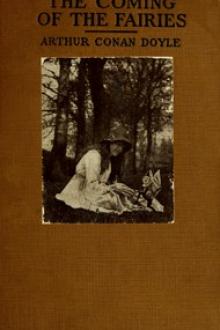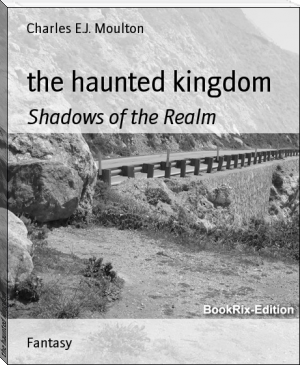The Coming of the Fairies, Arthur Conan Doyle [motivational novels .TXT] 📗

- Author: Arthur Conan Doyle
- Performer: -
Book online «The Coming of the Fairies, Arthur Conan Doyle [motivational novels .TXT] 📗». Author Arthur Conan Doyle
Mr. Snelling's report on the two negatives is positive and most decisive. He says he is perfectly certain of two things connected with these photos, namely:
1. One exposure only; 2. All the figures of the fairies moved during exposure, which was "instantaneous."As I put all sorts of pressing questions to him, relating to paper or cardboard figures, and backgrounds and paintings, and all the artifices of the modern studio, he proceeded to demonstrate by showing me other negatives and prints that certainly supported his view. He added that anyone of considerable experience could detect the dark background and double exposure in the negative at once. Movement was as easy, as he pointed out in a crowd of aeroplane photos he had by him. I do not pretend to follow all his points, but I am bound to say he thoroughly convinced me of the above two, which seem to me to dispose of all the objections hitherto advanced when they are taken together! Mr. S. is willing to make any declaration embodying the above and stakes his reputation unhesitatingly on their truth.
I am away from London from Wednesday next till the 28th when I go on to Bingley for one or two days' investigation on the spot. I propose that you have the two negatives, which are carefully packed and can be posted safely, for this fortnight or so. If you would rather not handle them I will send them to Mr. West of Kodak's, or have them taken to him for his opinion, for I think, as you say, it would be worth having, if he has had direct and extensive practical experience.
I am very anxious now to see this right through, as, though I felt pretty sure before, I am more than ever satisfied now after that interview the other day.
Yours sincerely,
Edw. L. Gardner.
B. ELSIE AND THE GNOME
Photograph taken by Frances. Fairly bright day in September, 1917. The "Midg" camera. Distance, 8 ft. Time, 1/50th sec. The original negative has been tested, enlarged, and analysed in the same exhaustive manner as A. This plate was badly under-exposed. Elsie was playing with the gnome and beckoning it to come on to her knee.
ELSIE AND FRANCES
A snapshot taken by Mr. Wright in June, 1917, with the "Midg" camera he had just obtained—his first and only camera.
COTTINGLEY BECK AND GLEN
Sites of photographs are marked A, B, C, D, E, and the cottage with an X.
After receiving this message and getting possession of the negatives I took them myself to the Kodak Company's Offices in Kingsway, where I saw Mr. West and another expert of the Company. They examined the plates carefully, and neither of them could find any evidence of superposition, or other trick. On the other hand, they were of opinion that if they set to work with all their knowledge and resources they could produce such pictures by natural means, and therefore they would not undertake to say that these were preternatural. This, of course, was quite reasonable if the pictures are judged only as technical productions, but it rather savours of the old discredited anti-spiritualistic argument that because a trained conjurer can produce certain effects under his own conditions, therefore some woman or child who gets similar effects must get them by conjuring. It was clear that at the last it was the character and surroundings of the children upon which the inquiry must turn, rather than upon the photos themselves. I had already endeavoured to open up human relations with the elder girl by sending her a book, and I had received the following little note in reply from her father:
31 Main Street, Cottingley, Bingley, July 12, 1920.
Dear Sir,
I hope you will forgive us for not answering your letter sooner and thanking you for the beautiful book you so kindly sent to Elsie. She is delighted with it. I can assure you we do appreciate the honour you have done her. The book came last Saturday morning an hour after we had left for the seaside for our holidays, so we did not receive it until last night. We received a letter from Mr. Gardner at the same time, and he proposes coming to see us at the end of July. Would it be too long to wait until then, when we could explain what we know about it?
Yours very gratefully,
Arthur Wright.
It was evident, however, that we must get into more personal touch, and with this object Mr. Gardner went North and interviewed the whole family, making a thorough investigation of the circumstances at the spot. The result of his journey is given in the article which I published in the Strand Magazine, which covers all the ground. I will only add the letter he wrote to me after his return from Yorkshire.
5 Craven Road, Harlesden, N.W.10, July 31, 1920.
My dear Conan Doyle,
Yours just to hand, and as I have now had an hour to sort things out I write at once so that you have the enclosed before you at the earliest moment. You must be very pressed, so I put the statement as simply as possible, leaving you to use just what you think fit. Prepared negatives, prints of quarter, half-plate, and enlarged sizes, and lantern slides, I have all here.
Also on Tuesday I shall have my own photographs of the valley scenery including the two spots shown in the fairy prints, and also prints of the two children taken in 1917 with their shoes and stockings off, just as they played in the beck at the rear of their house. I also have a print of Elsie showing her hand.
With regard to the points you raise:
1. I have definite leave and permission to act as regards the use made of these photographs in any way I think best.
Publication may be made of them, the only reserve being that full names and addresses shall be withheld.
2. Copies are ready here for England and U.S.A.
3. ... The Kodak people and also the Illingworth Co. are unwilling to testify. The former, of course, you know of. Illingworths claim that they could produce, by means of clever studio painting and modelling, a similar negative. Another Company's expert made assertions concerning the construction of the "model" that I found were entirely erroneous directly I saw the real ground! They, however, barred any publication. The net result, besides Snelling's views, is that the photograph could be produced by studio work, but there is no evidence positively of such work in the negatives. (I might add that Snelling, whom I saw again yesterday evening, scouts the claim that such negatives could be produced. He states that he would pick such a one out without hesitation!)
4. My report is enclosed and you are at perfect liberty to use this just as you please.
The father, Mr. Arthur Wright, impressed me favourably. He was perfectly open and free about the whole matter. He explained his position—he simply did not understand the business, but is quite clear and positive that the plate he took out of the Midg camera was the one he put in the same day. His work is that of electrician to an estate in the neighbourhood near. He is clear-headed and very intelligent, and gives one the impression of being open and honest. I learnt the reason of the family's cordial treatment of myself. Mrs. Wright, a few years back, came into touch with theosophical teachings and speaks of these as having done her good. My own connection with the Theosophical Society she knew of and this gave them confidence. Hence the very cordial reception I have met with, which somewhat had puzzled me.
By the way, I think "L.'s" guide ran up against innocent little Snelling! He matches the description quite well, as I realized last night. And he did prepare the new negatives from which the prints you have were made, and he has a room full up with weird machines with handles and devices used in photography....
Sincerely yours,
Edw. L. Gardner.
I trust that the reader will agree that up to this point we had not proceeded with any undue rashness or credulity, and that we had taken all common-sense steps to test the case, and had no alternative, if we were unprejudiced seekers for truth, but to go ahead with it, and place our results before the public, so that others might discover the fallacy which we had failed to find. I must apologize if some of the ground in the Strand article which follows has already been covered in this introductory chapter.
THE FIRST PUBLISHED ACCOUNT—"STRAND" CHRISTMAS NUMBER, 1920
Should the incidents here narrated, and the photographs attached, hold their own against the criticism which they will excite, it is no exaggeration to say that they will mark an epoch in human thought. I put them and all the evidence before the public for examination and judgment. If I am myself asked whether I consider the case to be absolutely and finally proved, I should answer that in order to remove the last faint shadow of doubt I should wish to see the result repeated before a disinterested witness. At the same time, I recognize the difficulty of such a request, since rare results must be obtained when and how they can. But short of final and absolute proof, I consider, after carefully going into every possible source of error, that a strong prima facie case has been built up. The cry of "fake" is sure to be raised, and will make some impression upon those who have not had the opportunity of knowing the people concerned, or the place. On the photographic side every objection has been considered and adequately met. The pictures stand or fall together. Both are false, or both are true. All the circumstances point to the latter alternative, and yet in a matter involving so tremendous a new departure one needs overpowering evidence before one can say that there is no conceivable loophole for error.
It was about the month of May in this year that I received the information from Miss Felicia Scatcherd, so well-known in several departments of human thought, to the effect that two photographs of fairies had been taken in the North of England under circumstances which seemed to put fraud out of the question. The statement would have appealed to me at any time, but I happened at the moment to be collecting material for an article on fairies, now completed, and I had accumulated a surprising number of cases of people who claimed to be able to see these little creatures. The evidence was so complete and detailed, with such good names attached to it, that it was difficult to believe that it was false; but, being by nature of a somewhat sceptical turn, I felt that something closer was needed before I could feel personal conviction and assure myself that these were not thought-forms conjured up by the imagination or expectation of the seers. The rumour of the photographs interested me deeply, therefore, and following the matter up from one lady informant to another, I came at last upon Mr. Edward L. Gardner, who has been ever since my most efficient collaborator, to whom all credit is due. Mr. Gardner, it may be remarked, is a member of the Executive Committee of the Theosophical Society, and a well-known lecturer upon occult subjects.
He had not himself at that time mastered the whole case, but all he





Comments (0)